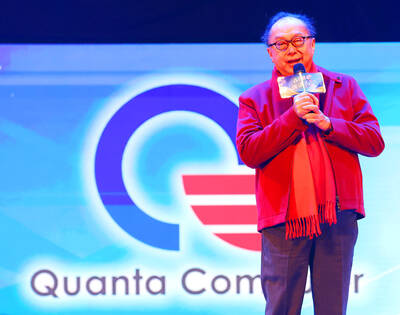Robust export expansion will sustain the nation’s economic growth this year despite flagging demand from the US, while rising inflation at home and abroad will continue to dent corporate profit margins and consumer spending, the Academia Sinica said yesterday.
The nation’s top research institute raised its GDP growth forecast for this year to 4.55 percent, up from the 4.31 percent it estimated in December thanks to better-than-expected exports.
The think tank also hiked its annual inflation forecast from 1.93 percent to 3.93 percent, the highest in 14 years.
Wu Chung-shu (吳中書), a research fellow at the Academia Sinica, said the revised numbers sends a mixed message.
While the nation posted an impressive GDP growth of 6.06 percent in the first quarter, economic expansion is expected to trend downward for the rest of the year, rising by an estimated 4.53 percent in the second quarter, 4.03 percent in the third quarter and 3.71 percent in the fourth quarter, Wu said.
The economist ascribed the trend to mounting fuel and raw material costs that are expected to push up the consumer price index by 3.93 percent this year, the highest since 1994.
Against this backdrop, companies are disinclined to raise wages, depriving employees of the incentive to spend, Wu said.
Real wages, or nominal wage growth minus inflation, recorded a decline of 1.9 percent in the first four months of this year, the biggest drop since the government statistics agency started compiling data on the subject in 1980.
The figure is expected to widen later this year as CPI growth climbed 3.65 percent in May, 4.97 percent last month and is forecast to continue climbing for the rest of the year.
Utility prices are also rising, with Taiwan Power Co (台電) raising electricity rates by 12.6 percent this month and is scheduled to introduce another price hike in October.
Wu said that while exports continued to rise, imports accelerated at an even quicker pace.
The Ministry of Finance said on Monday that exports jumped 21.3 percent year-on-year last month to US$24.3 billion, while imports advanced 22.5 percent to US$22.86 billion, leaving a trade surplus of US$1.49 billion, up 4.9 percent from a year earlier.
Wu said that mounting expenses accounted for the increase in import value, citing a government report showing that companies had spent 20.61 percent and 15.91 percent less on capital equipment in May and last month respectively, compared with the same months a year earlier.
Unless the nation can boost domestic demand, the researcher said that prospects of wages and consumer spending increasing were dim.
Wu forecast that private consumption would increase by 1.73 percent and private investment would drop by 1.98 percent this year.
The economist said that Chinese tourists could be positive for the economy, but expressed doubts that it would be sufficient to offset the harm caused by inflation.
Wu said he expected the local currency to trade at an average of NT$30.69 against the US dollar this year.
The Academia Sinica’s revised GDP forecast was lower than the government’s estimate of 4.78 percent, Chung-Hua Institute for Economic Research’s (中經院) 4.67 percent, the Taiwan Research Institute’s (台綜院) 4.68 percent and Polaris Research Institute’s (寶華綜合經濟研究院) 4.6 percent.
Wu said the inflation Taiwan faces today is completely different from that the country witnessed in the early 1990s. Back then, he said, both the domestic real estate and stock markets were brisk despite a high CPI.
Salaries in the business and industrial sectors also saw 8 percent to 9 percent growth between 1991 and 1995 in spite of the high CPI, he said.
“People did not feel they were suffering when both salaries and inflation were high. They felt rich,” Wu said.
Additional reporting by CNA

Quanta Computer Inc (廣達) chairman Barry Lam (林百里) is expected to share his views about the artificial intelligence (AI) industry’s prospects during his speech at the company’s 37th anniversary ceremony, as AI servers have become a new growth engine for the equipment manufacturing service provider. Lam’s speech is much anticipated, as Quanta has risen as one of the world’s major AI server suppliers. The company reported a 30 percent year-on-year growth in consolidated revenue to NT$1.41 trillion (US$43.35 billion) last year, thanks to fast-growing demand for servers, especially those with AI capabilities. The company told investors in November last year that

Intel Corp has named Tasha Chuang (莊蓓瑜) to lead Intel Taiwan in a bid to reinforce relations between the company and its Taiwanese partners. The appointment of Chuang as general manager for Intel Taiwan takes effect on Thursday, the firm said in a statement yesterday. Chuang is to lead her team in Taiwan to pursue product development and sales growth in an effort to reinforce the company’s ties with its partners and clients, Intel said. Chuang was previously in charge of managing Intel’s ties with leading Taiwanese PC brand Asustek Computer Inc (華碩), which included helping Asustek strengthen its global businesses, the company

Taiwanese suppliers to Taiwan Semiconductor Manufacturing Co. (TSMC, 台積電) are expected to follow the contract chipmaker’s step to invest in the US, but their relocation may be seven to eight years away, Minister of Economic Affairs J.W. Kuo (郭智輝) said yesterday. When asked by opposition Chinese Nationalist Party (KMT) Legislator Niu Hsu-ting (牛煦庭) in the legislature about growing concerns that TSMC’s huge investments in the US will prompt its suppliers to follow suit, Kuo said based on the chipmaker’s current limited production volume, it is unlikely to lead its supply chain to go there for now. “Unless TSMC completes its planned six

Power supply and electronic components maker Delta Electronics Inc (台達電) yesterday said it plans to ship its new 1 megawatt charging systems for electric trucks and buses in the first half of next year at the earliest. The new charging piles, which deliver up to 1 megawatt of charging power, are designed for heavy-duty electric vehicles, and support a maximum current of 1,500 amperes and output of 1,250 volts, Delta said in a news release. “If everything goes smoothly, we could begin shipping those new charging systems as early as in the first half of next year,” a company official said. The new